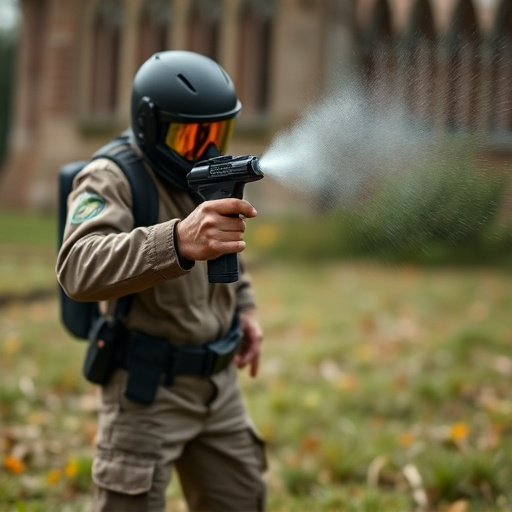OC spray effectiveness depends on capsaicin concentration (ppm), with 1-2% offering moderate protection and higher levels providing stronger deterrence. Balancing power, side effects, and legal restrictions is crucial when selecting OC spray for self-defense, ensuring optimal performance while adhering to regional regulations.
“Uncover the power of self-defense with an innovative tool—the OC spray device. This article delves into the intricate world of OC spray, focusing on its active ingredient, capsaicin, and its concentration levels. We explore how these concentrations dictate its effectiveness in defense scenarios.
From understanding the chemical composition to navigating legal boundaries, this guide provides insights into the crucial factors surrounding OC spray’s use. Learn about capsaicin concentration levels and their impact on personal safety.”
- Understanding OC Spray and Capsaicin Composition
- Deciphering Concentrations: What Does It Mean?
- Effectiveness: How OC Spray Concentration Impacts Defense
- Legal Considerations: Exploring Capsaicin Limits and Usage
Understanding OC Spray and Capsaicin Composition
OC spray, also known as pepper spray, is a non-lethal self-defense tool that uses capsaicin, the active ingredient found in chili peppers, to cause temporary blindness and pain in the target’s eyes and respiratory system. The effect is swift but temporary, giving users valuable time to escape potentially dangerous situations.
The composition of OC spray varies, but typically, it contains a high concentration of capsaicin, often between 1% to 2%. This concentration level ensures its effectiveness as a deterrent. The spray’s formula also includes other ingredients like water, a surfactant for better adherence, and an UV inhibitor to maintain stability. Understanding the capsaicin composition is crucial in choosing the right self-defense device, as higher concentrations provide more power but also increase the risk of side effects and skin irritation.
Deciphering Concentrations: What Does It Mean?
When it comes to self-defense devices like inflammatory spray, understanding the capsaicin concentration levels is key. OC (oleoresin capsicum) spray, commonly known as pepper spray, works by irritates the eyes and respiratory system through its active ingredient, capsaicin. The concentration of this ingredient determines its effectiveness and how far it can reach.
Capsaicin concentration is typically measured in parts per million (ppm). Higher ppm means more capsaicin, which translates to stronger irritation and a longer range of impact. However, it’s not just about strength; factors like spray pattern, wind, and target distance also play significant roles in the overall effectiveness. Thus, choosing the right OC spray involves balancing capsaicin concentration levels with these practical considerations for your specific self-defense needs.
Effectiveness: How OC Spray Concentration Impacts Defense
The effectiveness of a self-defense inflammatory spray device, often referred to as OC (Oleoresin Capsicum) spray, is directly linked to its capsaicin concentration levels. Capsaicin, the active ingredient in chili peppers, is what causes the burning sensation and can deter an attacker. The higher the concentration, typically measured in percent or milliliters per gram, the more potent the spray. A device with a 1% capsaicin concentration is considered mild but still effective for self-defense purposes, while those with concentrations above 2% are significantly stronger and can cause temporary blindness and severe pain.
Choosing the right OC spray depends on individual needs and legal restrictions in their region. It’s important to understand that while higher capsaicin levels offer more protection, they may also result in longer recovery times for the user. As such, selecting a device with an appropriate concentration level should balance personal safety against potential side effects, ensuring the tool serves its intended purpose effectively without causing undue harm to the defender.
Legal Considerations: Exploring Capsaicin Limits and Usage
When considering self-defense inflammatory spray devices, one must navigate a complex web of legal considerations. The primary focus here is capsicum spray, often referred to as OC spray, and its usage limits. Each jurisdiction has specific laws dictating the concentration levels of capsaicin allowed in such devices. These regulations are designed to balance personal safety with public safety, ensuring that the force used is proportionate to the threat.
OC Spray capsaicin concentration levels play a pivotal role in determining legality. While higher concentrations offer more potent protection, they also come with stricter restrictions. Lower concentrations might be less disruptive but could potentially be less effective against determined attackers. Understanding these nuances is essential for users to stay within legal boundaries and ensure the device’s utility as a legitimate self-defense tool.
Self-defense inflammatory spray devices, or OC spray, have proven to be a powerful tool for personal safety. Understanding the capsaicin composition and its concentration levels is essential in maximizing their effectiveness while navigating legal considerations. The right OC spray can provide individuals with a crucial layer of protection, ensuring peace of mind in potentially dangerous situations. By choosing products with specific concentration levels tailored to their needs, users can confidently defend themselves and stay ahead of potential threats.
